Fertilizing and fertilizing blueberries in spring, summer and autumn
Recently, blueberries have been increasingly found in summer cottages. However, not all gardeners can boast of a good harvest. The thing is that the plant is very demanding not only on the acidity of the soil, but also on its nutritional value (although it is primarily about acidity).
How can you feed blueberries in spring and summer to improve the quality and increase the yield of wild berries? Now you will find out everything.
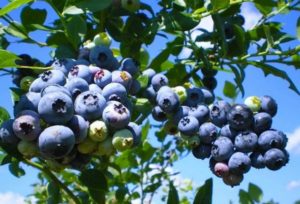
Content
- 1 Features of growing blueberries: what fertilizing are required
- 2 When to feed blueberries in spring, summer and autumn: optimal timing and scheme
- 3 How to feed blueberries in spring, summer and autumn: fertilizer options
- 4 Special fertilizers for blueberries (including acidic ones)
- 5 How to acidify the soil under blueberries: the best acidifiers
Features of growing blueberries: what fertilizing are required
The main distinguishing feature of growing blueberries in the garden is the need for an acidic environment (3.5-5 pH).Therefore, blueberries are planted in an acidic peat mixture (based on marsh red or high peat, 50-60%), mixed with coniferous litter (rotted pine needles, 30-40%) and sand (10%).
If you plant blueberries in ordinary garden soil of a neutral reaction, or even more so in alkaline soil, then you can not even dream of any significant yields. The shrub will grow poorly and stunted.
However, just planting blueberries in acidic soil and using conventional fertilizers is not enough, over time, in any case, you will need to maintain acidity at the required level (since it will decrease), namely, feed the blueberries with acidic fertilizers or use special acidifiers (not fertilizers! ).
Interesting! The fact is that a specific fungus lives on the roots of blueberries in close symbiosis (symbiotic connection) - ericoid mycorrhiza, which helps the plant to absorb nutrients from the soil, and it lives only at low acidity. In other words, the acidic environment is needed not by the blueberry itself, but by the mycorrhiza, which is located on the roots of the blueberry.
However, often novice gardeners focus exclusively on creating an acidic environment, not paying due attention to feeding with basic macro- and microelements, and blueberries, like other cultivated plants, need nitrogen, phosphorus, potassium, magnesium, sulfur and other nutrients.
Advice! Be sure to purchase special instruments for measuring soil acidity.
Video: how to water and fertilize blueberries
When to feed blueberries in spring, summer and autumn: optimal timing and scheme
Many experienced gardeners follow this blueberry feeding scheme in spring, summer and autumn:
Naturally, the composition of the fertilizer differs from the season and the phase in which the plant is located.
- The first feeding of blueberries is done immediately after waking up (after the snow melts) and swelling of the buds, in other words, during the period of active growth of the vegetative mass. It (top dressing) should consist mainly of nitrogen fertilizers (ideally, ammonium sulfate). But you can take a complex mineral fertilizer, in which there are equal parts of all macroelements, such as nitroammophoska (16% nitrogen, phosphorus and potassium each).
- The second feeding is carried out after flowering (at the beginning of the formation of ovaries and ripening of berries). Its goal is to improve the quality and sugar content of the fruit, which means that it is necessary to fertilize blueberries with potash fertilizers (+ trace elements, especially magnesium).

- The last (autumn) feeding of blueberries is done after fruiting and picking berries, i.e. in the fall. The purpose of this autumn dressing is to help the shrub plant new flower buds for the next year, as well as prepare the plant for winter (to strengthen the immune system and improve its winter hardiness). So it should be phosphoric-potassium fertilizer (the same superphosphate + potassium sulfate).

Important! Throughout the growing season, you need to control the acidity of the soil (it is optimal to keep it in the region - 3.5-5 pH) and, if necessary, be sure to acidify with special solutions (about which read in a separate paragraph "How to acidify the soil under blueberries")
How to properly feed blueberries
Basic recommendations and rules for effective fertilization of blueberries in the garden:
- Before fertilizing, around the trunk circle of the bush (departing from it by 15-20 cm) you should make a small (absolutely shallow) groove, where you need to apply top dressing in liquid form, or scatter dry granules over the soil surface, followed by incorporation of fertilizers by loosening. Then water abundantly.
After fertilization, you can lightly sprinkle the grooves with sour high peat or other suitable sour mulch (pine litter).
- Before feeding blueberries, it is recommended to first spill the bushes with plain watersince it should be fertilized on wet soil, especially with mineral fertilizers.
By the way! If a good rain has recently passed, and the ground is sufficiently wet, then additional moistening (watering) is not necessary.
Advice! In general, it is advisable to shed the earth at least a couple, and even better one day before applying top dressing.
- Top dressing should be done in the morning or evening, or in the afternoon in cloudy weather.
- Usually, in spring are carried out precisely root dressing (in liquid form, but also dry). A in summer, during the fruiting period, you can perform and foliar feeding (by leaves).
Note! It is believed that foliar feeding is most effective when the plant especially needs certain microelements (which is manifested in its appearance). For example, in the case of chlorosis.
Worth knowing! Foliar dressing cannot completely replace root dressing.
- As for the dosages (dilution proportions) and the timing of the application of certain fertilizers, always follow the instructions on the packages, do not rely on memory.
How to feed blueberries in spring, summer and autumn: fertilizer options
There are many effective ways to feed blueberries. Some are more expensive, others are less, in any case, the choice is yours.
Let's move on to the point, namely, we will consider in detail and list the main fertilizers suitable for feeding blueberries in spring and summer, as well as in autumn (after fruiting and picking berries).
Note! Blueberries are a "acid-loving" plant, which means that in alkaline soil they will very poorly absorb any food.
So by no means you can't feed blueberries wood ash or other deoxidizers that alkalize (lower acidity) the soil.
Also can't use chlorine fertilizers (those. need chlorine-free).
Next, we will take a closer look at what fertilizers can be used, as well as how to combine them.
Nitrogen fertilizers
Used only in spring and early summer.
Mineral:
Note! The best nitrogen fertilizer is ammonium sulfatesince contains not only nitrogen, but also is an excellent soil acidifier (contains sulfur).
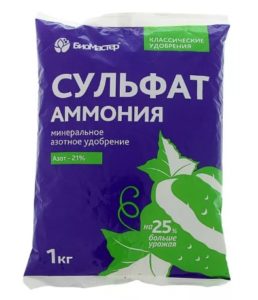
- Urea (Urea) - 46% nitrogen (20-30 grams per 10 liters of water or per 1 square meter);

- Ammonium nitrate - 33% nitrogen (30-40 grams per 10 liters of water or per 1 square meter).

Organic nitrogen fertilizers:
Note! Blueberry does not like any organic matter! Another thing is pine litter (necessarily rotted) or coniferous sawdust.
Complex mineral nitrogen-phosphorus-potassium dressing
It is very convenient to use complex mineral fertilizers, which contain all the macronutrients.
So, blueberries in the spring (before flowering) can be fed with the following fertilizers:
- Nitroammofoska (nitrogen, phosphorus, potassium - 16% each). Prepare the solution at the rate of 20-30 grams per 10 liters of water.
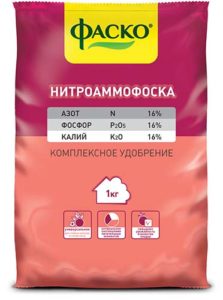
- Diammofoska - 10% nitrogen, 26% phosphorus and potassium each (20-30 grams per 10 liters of water).
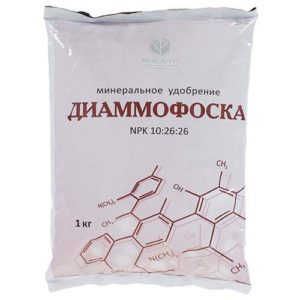
Note! The composition of these fertilizers does not include any trace elements, and it is very desirable to add them. Therefore, it is highly recommended to add humates to solutions, for example, the same Potassium humate.
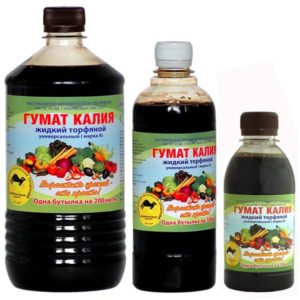
Or complex ready-made cocktails with trace elements such as Humate +7 Iodine.
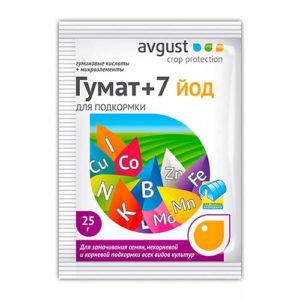
- Plantofid or Plantofol (20:20:20).

Potassium phosphorus fertilizers
Suitable for feeding after flowering and at the beginning of fruiting, as well as in autumn.
- Potassium sulfate (potassium sulfate) - 46-52% potassium (20-30 grams).
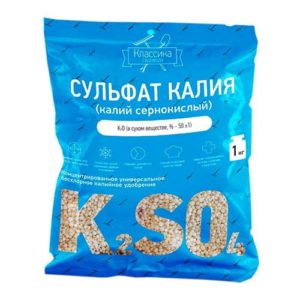
By the way! Instead of potassium sulfate (potassium sulfate), you can use potassium nitrate (Nitrogen -13.6, Potassium 46%).
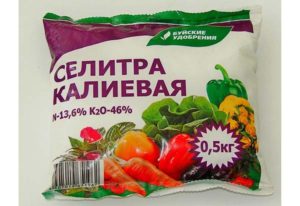
And it is also very convenient to use potassium magnesium, which, in addition to potassium, contains such an important trace element as magnesium.
Interesting! Magnesium, which promotes the process of photosynthesis, provides brightness and green foliage, prevents aging.
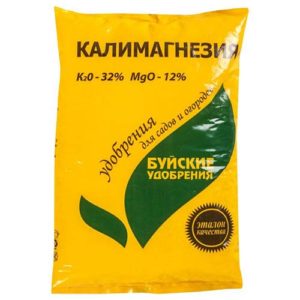
Note! In no case you can't feed blueberries wood ash (using as a potassium supplement) or other deoxidizers that alkalize (reduce acidity) the soil
Rapidly assimilated phosphorus and phosphorus-potassium dressing
Suitable for feeding before and after flowering (during fruiting).
To make an easily digestible infusion superphosphate for spring feeding of blueberries, you must:
Take potassium monophosphate, dissolve in water and fertilize. However, it is not always possible to find it in the store, and it is quite expensive.
Or:
- 1 kg double superphosphate pour 5 liters of boiling water;
- after the water has cooled, add 0.5 liters of 9% vinegar;
Acidifying the water will help convert the calcium phosphate to a more soluble form.
- Let it brew for 12-24 hours, shaking and stirring occasionally.
- Add another 5 liters of water, bringing the total volume to 10 liters.
- Then dilute 1 liter of the resulting superphosphate infusion with 10 liters of water (1 to 10).
- Conduct top dressing.
By the way! You can also purchase a water-soluble fertilizer such as Plantafol or Plantafid (5:15:45).
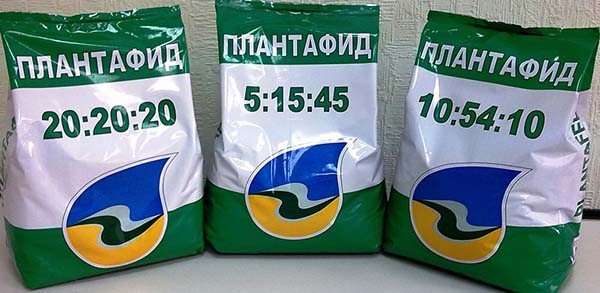
Autumn potassium-phosphorus fertilizing (after harvest)
The following combinations of mineral fertilizers can be an excellent option for feeding blueberries after fruiting and harvesting (i.e. in autumn).
First option:
- Superphosphate - nitrogen 6-9%, phosphorus - 26-30% (30-40 grams per 10 liters of water or 1 sq. M.).
By the way! The site has a separate material about how to apply superphosphate.
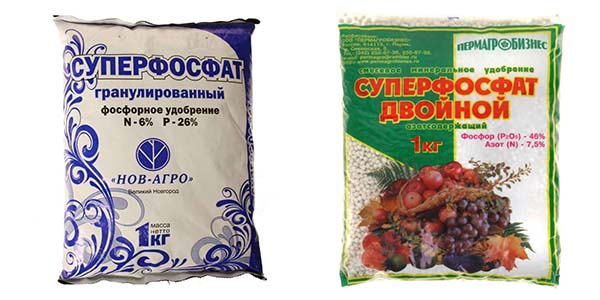
- Potassium sulfate (potassium sulfate) - 46-52% potassium (20-30 grams per 10 liters or 1 square meter).

Second option:
- Diammofoska - 10% nitrogen, 26% phosphorus and potassium (20-30 grams per 10 liters or 1 square meter).

Third option:
- Potassium monophosphate (Phosphorus - 50%, potassium - 33%) - 20-30 grams per 10 liters or 1 square meter;
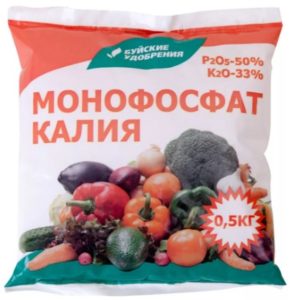
Think! It is believed that blueberries can do without mineral fertilizers at all, because it is primarily a forest plant, and they are more destructive than useful for her.
You can learn more about this by watching the following video:
Video: how to choose fertilizer for blueberries
Special fertilizers for blueberries (including acidic ones)
If you don't want to bother too much, now it is easy to find special fertilizers for heather crops on sale: the same azaleas, rhododendrons, hydrangeas, as well as blueberries and other forest berries (lingonberries, cranberries, viburnum), which contain not only a balanced combination of micro - and macronutrients, but also soil acidifiers.
Thus, the most popular special fertilizers for blueberries are as follows:
- Florovit for blueberries. In addition to the main macronutrients, it contains magnesium, iron, zinc and copper, which prevent yellowing of leaves during the growing season.
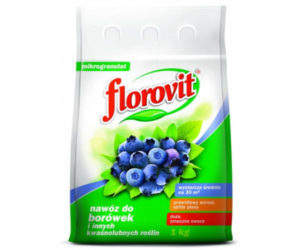
- "Bona Forte" for blueberries and wild berries. Fertilizer of prolonged (long-term) action (it is enough to apply once a season).
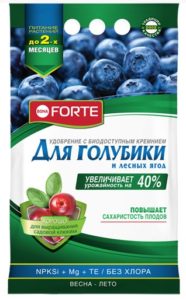
- "Good power" for blueberries and wild berries (Berry No. 2).

- «Lifdrip»Blueberries, cranberries, rhododendron, azalea.

- "Yara Mila" and others.

Advice! As mentioned earlier, fertilizers for rhododendrons, azaleas and hydrangeas are suitable for feeding, which means that it will be useful for you to read about these fertilizers. in a separate article on feeding hydrangeas.
How to acidify the soil under blueberries: the best acidifiers
Thus, if you want blueberries to bear fruit abundantly and not suffer from chlorosis, then the soil under it should always be acidic (3.5-5 pH), which means that you need to acidify it periodically.
Most gardeners call the easiest and cheapest way to acidify the soil using sulfur (you can buy regular ground, granulated in garden stores or feed in veterinary pharmacies).
Usage advice! Sulfur does not dissolve in water, so it is better to sprinkle it evenly around the bush and pour on top from a watering can. If some of the sulfur remains on the surface, it's not scary, under the influence of rain or irrigation it will gradually oxidize and go down, lowering the acidity of the soil.
Note! Sulfur does not act instantly, but gradually, but the effect is long-lasting.
It is enough to add 50-100 grams of sulfur once every 1-2 years per 1 bush (the more accurate dosage depends on the initial acidity and type of soil).
Video: how to properly acidify blueberries with sulfur - the best way
You can also acidify the soil under blueberries with the following compositions and solutions:
By the way! The effect of their use is instant, but short (short).
- slightly acidic solution electrolyte or sulfuric acid (10 ml per 10 l of water);
Important! In no case should you use the electrolyte drained from the battery, since it contains lead, antimony and other heavy metals.
No used, only fresh!
- apple cider vinegar (100 ml of 9% vinegar per 10 liters of water);
- citric acid (20-40 g per 10 l of water).
Advice! Moreover, it is very desirable to additionally add iron chelate to the above solutions or inkstone (20-30 grams per 10 liters).
As for the frequency of introducing such fast acidifiers, as a rule, they are introduced every 2-4 weeks, at least 2-4 times per season (Important! This does not apply to sulfur, it is applied 1-2 times every 2 years).
Video: how to acidify blueberries - watering with electrolyte
Folk remedies and sour organic food
If you do not have the opportunity to purchase special acidic fertilizers or you are a supporter of organic matter, then you can acidify blueberries with the following fertilizers:
- Infusion of sour herbs... Chop the leaves and stems of the following acidic crops as finely as possible (suitable rhubarb, sorrel, oxalis or hare cabbage), fill with water and let it brew for 2-4 days, water at the root.
- Lemon juice solution (2-3 lemons per 10 liters of water).
Also as very light sour dressings you can mulch blueberries with sour red or high peat, coniferous (spruce, pine) litter, rotted pine needles, bark.
Important! In no case should blueberries be mulched with humus (since it has an alkaline reaction, and we need an acidic one!).
Video: how to feed blueberries
Thus, now you know how to properly feed and acidify blueberries. Yes, this is not so simple, but the result is worth it.
Video: secrets of fertilizing and feeding blueberries


Thank you. Very good information. Available to everyone.
Is peat pH 2.8-3.3 okay?
Quite, high-moor peat is always about this acidity.
Thank you very useful information!